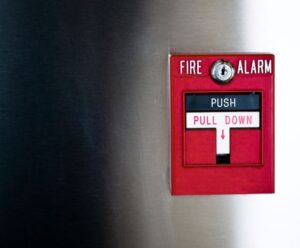
Initiating devices are connected to a fire alarm system’s control panel and can be activated manually or automatically during a fire emergency.
Fire alarm systems consist of various complex devices that play a significant role in detecting, controlling, and reducing the spread of commercial fires. These devices are known as initiating devices. Initiating devices are connected to a fire alarm system’s control panel and can be activated manually or automatically during a fire emergency. They’re one of the most visible parts of your system and play a significant role in protecting a building and its occupants from the damages and hazards linked to fires. Continue reading to learn more about the similarities and differences between manual and automatic fire alarm initiating devices.
Manual Fire Alarm Initiating Devices
Manual initiating devices are key components of a fire alarm system that must be operated manually. One of the most common fire alarm initiating devices is manual pull stations that have to be activated by pulling down a lever or pressing a button. Manual pull stations are typically tiny red boxes mounted on a wall in designated areas of commercial properties such as offices, retail stores, schools, hospitals, event centers, and more. There are two types of manual pull stations, including a single-action pull station and a dual-action pull station. A single-action pull station is simple and attached to walls without any cover, allowing them to be activated by one action, simply pulling a lever. However, dual-action pull stations are typically encased in glass or plastic, requiring a two-step activation sequence, including breaking or removing its casing and then pulling a lever to activate the alarm. Manual pull stations can be operated by anyone allowing people inside of a building to activate them in a fire emergency.
Automatic Fire Alarm Initiating Devices
Like its name, automatic initiating devices are key components of fire alarm systems that automatically activate after detecting heat, smoke, or fire. These devices are essential in quickly identifying and responding to a fire before it develops or spreads, ensuring the safety of a building and its occupants. Typically, when one automatic initiating device is activated, others respond shortly after. There are two types of automatic fire alarm initiating devices: a spot-type and a linear type. Spot-type devices detect smoke, heat, and fire within the immediate area where the device is located. While linear type devices can detect smoke over a wide range of space, transmitting the alarm signal to your fire alarm system’s control panel. Listed below are some of the typical automatic fire alarm initiating devices used in commercial properties:
- Smoke detectors
- Heat detectors
- Flame detectors
- Smoke Detectors
- Duct detectors
- Sprinkler systems
Contact Chesapeake Sprinkler Company Today!
Chesapeake Sprinkler Company is a leading fire sprinkler contractor in the region. As a full-service fire protection company, we offer design, fabrication, installation, testing, maintenance, and inspection of fire protection systems. Everything you need from your fire suppression specialist.
For more information, please email or call our Odenton location at 410-674-7041, our Ashburn location at 703-729-5150, or for service/maintenance Chesapeake Protection Services at 410-674-7577. For emergencies, call 800-298-3473 (FIRE). Feel free to keep in touch through Facebook, Twitter, or LinkedIn!
